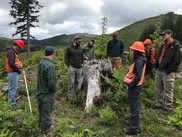|
Having trouble viewing this email? View it as a Web page.

|
|
|
Fresh From the Field is a weekly album showcasing transformative impacts made by partners supported by the National Institute of Food and Agriculture.
Editor: Falita Liles Feb.21, 2019
|
|
Success Stories

Reduced Herbicide Use in Tree Plantations Preserves Biodiversity and Maintains Profitability
Oregon State University and the National Council for Air and Stream Improvement conducted large-scale experiments to test the effects of herbicides on pollinators and other insects, deer and elk, birds, and plant species. Herbicide applications negatively affected biodiversity in the first five years, but impacts lessened considerably in later years. Importantly, although there are tradeoffs between forest wood production and biodiversity, researchers found no such tradeoffs with profitability once economic discount rates were taken into consideration. This indicates that there could be optimal management strategies that do not compromise biodiversity, but maintain profitability.
NIFA supports this research through the Agriculture and Food Research Initiative.
To learn more, please visit the Betts Forest Landscape Ecology Lab.
|
News Coverage

Wildfires Affects Molecular Nitrogen and Water Quality
Forest fires are increasing in frequency and intensity in the western United States. Researchers at the University of California, Davis evaluated the effects of wildfire on the molecular transformation of nitrogen. Wildfires may affect water quality by potentially altering the chemistry and quantity of dissolved nitrogen and dissolved organic matter, causing adverse effects on both aquatic ecosystems and human health. Results indicated that potential pollutants are highly dependent on wildfire temperature and oxygen availability; however, elevated pollutant loads were especially pronounced in the first year following wildfire. Downstream water managers use this information to address reservoir eutrophication potential. As wildfires are expected to become more frequent and intensive due to climate change, understanding wildfire impacts on water quality are important to guiding watershed management and post-fire remediation actions.
NIFA supports this research through Hatch Act Funds.
Read more about this project through NIFA's Data Gateway. Photo by U.S. Forest Service.
|
Library

Separation and Detection of Chemical and Biological Contaminants in Fresh Produce by a SERS-Based Sensing Platform
Fresh produce is increasingly associated with chemical and biological contaminants, such as pesticides and foodborne pathogens. Early and rapid detection of contaminants is an important step in ensuring food safety. Dr. Mengshi Lin of the University of Missouri is developing a system that will detect, separate, and extract foodborne contaminants by using a surface-enhanced Raman spectroscopy platform. This system is based on hybrid nanocellulose films coupled with separation devices. It will help maintain the safety and sustainability of agriculture and food systems in a cost-effective and environmentally friendly manner.
NIFA supports the Agriculture and Food Research Initiative. University of Missouri photo.
|
Tweet of the Week
#NIFAIMPACTS

|
|

NIFA’s mission is to invest in and advance agricultural research, education, and extension that solve societal challenges. NIFA’s investments in transformative science directly support the long-term prosperity and global preeminence of U.S. agriculture. To learn more about NIFA’s impact on agricultural sciences, visit www.nifa.usda.gov/Impacts, sign up for email updates or follow us on Twitter @USDA_NIFA, #NIFAImpacts.
USDA is an equal opportunity lender, provider, and employer.
|
|